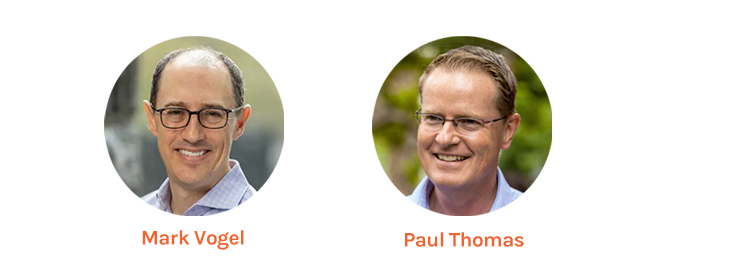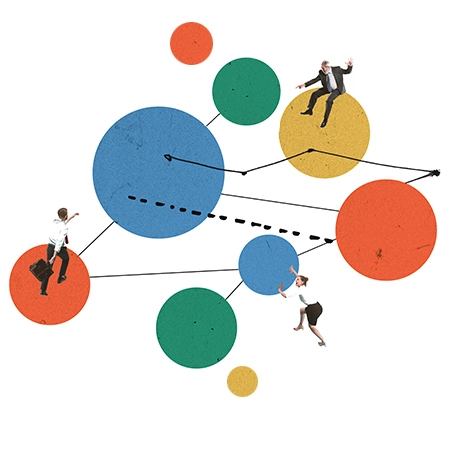In our continuing effort to grow our global reach, we recently merged with Strive Insight, a London-based firm known for their strategic thinking and consulting skills. Our Global Growth blog series features conversations with leaders from Radius and Strive offering their perspective on our Brand Growth Navigator approach. In this post, Paul Thomas and Mark Vogel discuss how they design segmentation studies for brands that have a presence in multiple markets.

At the start of a new targeting research project, what steps do you take to identify the best approach for segmentation?
PAUL THOMAS: Every segmentation is different, but to me there are two key constants in every segmentation that make it successful especially across multiple geographies and teams. Firstly, it’s about getting the different stakeholders, regions etc, all on board up front so they’re on the journey with you and they feel that they own it. The second thing for me is making sure at the start of the program that there’s a clear rollout plan when you get to the end. I’ve been on segmentations that fail because the regions weren’t bought into it in the beginning, and so never used it, or we got to the end of the segmentation and the team is wondering, “what do we do with it now?” because they hadn’t been fully engaged early on.
MARK VOGEL: Yes, I agree. Early engagement with the key stakeholders and regions is vital. You really want to understand what makes each country unique or different. You want to understand the lay of the land as you get into the initial research. Should we be expecting similarities across these countries, or are we expecting differences? Is the client looking for a global segmentation or are they looking for a bunch of individual segmentations? And then discovering how it all feeds into the outcome for the brand. It all ties together and is, in essence, a lot of conversations with the client and the right people on the client side. It’s not just the immediate stakeholders. You want to make sure they’re covering up with all the leaders in those regions, as well.
What type of consultative role do you play to ensure all stakeholders are aligned with project goals?
PAUL: As the research agency, we are in a unique position to be able to talk with each market independently and bring all of their views back to the table. This works well because the individual market or stakeholder groups feel like they’re being heard, and that their views are being considered in the overall project.
One thing that we really advocate is that the client creates a core team on their side that represents the different functions that will use the segmentation, like sales, marketing, innovation, and regions. That core team acts as an advisory group for the research process. They help us guide through the process and become advocates for the research on the backend.
MARK: Yes, that core team acts as a vital steering group. As we create the questionnaire and gather insights we’re coming back to that group, not just the research team, to make sure that we have buy-in. They tell us if we should go left or right, guide us through the process, and become advocates for the research on the back end when we start rolling out the insights.
How do you design research to ensure there are identifiable segments and targets in each market that balance brand goals with in-market needs?
MARK: In essence, as we conduct stakeholder interviews across the organization, we’re doing this due diligence phase, collecting a lot of information to understand the sticky points and commonalities across all the people we talk to — what do they really like or agree might make a great segment, or the things they dislike. Then we prioritize and get buy-in internally to ensure everyone’s on the same page. This helps us avoid surprises during presentations. The questionnaire becomes specific based on the questions created during this phase, making the research more targeted and effective.
PAUL: Yes, it’s about identifying what absolutely needs to be there to drive the segmentation, prioritizing the key inputs and reassuring stakeholders that we will address other information needs later. Segmentation creation is just the start of the journey; it needs to evolve with added insights over time. We balance including core information in the first step with the understanding that additional insights can be incorporated later on.
How do you help teams throughout the organization refine segments and integrate them into their work?
PAUL: We involve the teams in the evaluation of the different segmentation solutions, so they feel ownership and feel that they have had key input on the shape of the final solution. Then, we develop compelling activation material to educate the business on the segments and align them with work streams to develop opportunities. So, it’s about upfront engagement, deep involvement in the solution, and inspiring activation at the end.
MARK: Yes, as we’re going through the activation process, we keep asking the teams how they plan to use the segmentation. It’s crucial to align the segments with their specific goals. We want to articulate the segments to how the team will use them and tailor the rollout to their needs, so they resonate with their objectives. For example, if it’s an innovation goal, we present the segments in a way that showcases how the team can use the segments to support innovation and then help them understand the next steps after that.
PAUL: Also, working across multiple geographies, language and localisation becomes crucial. We need to describe the segments in a way that is embedded in the local context to ensure understanding and usage. For example, if we’re introducing a global segmentation in India, we must ground it in the contextual framework of the Indian market to ensure it is relevant and actionable. Tailoring the segmentation to local contexts helps avoid resistance and ensures adoption across regions.
What are tools do you provide to help teams find their targets going forward?
MARK: Our primary objective is to deliver powerful segmentation tools in a simple and concise manner. We understand the importance of making the segmentation process easy to implement and use across the organization. By keeping questionnaires succinct, we ensure that the segmentation tool remains effective without overwhelming users. Ultimately, our goal is to provide clients with not just data, but actionable insights that drive meaningful change.
In addition to ensuring stakeholders across the organization understand and get to know the segments, we also want to ensure that the research team has essentials such as a typing tool to help them in their continued work with the segments. When the segments are baked into the whole process, loaded into email systems, database marketing tools, and all the segments are tagged, that’s when it truly becomes powerful.
Can you share some examples of targeting initiatives you’ve been involved with?
PAUL: Early wins are crucial for energizing the organization. I did a segmentation a number of years ago for a retail client where we identified a simple segment that the client wasn’t doing well with. They were able to quickly formalize an offer for that segment based on the new information and created a targeted print based comms campaign almost overnight to activate the proposition. It resulted in their fastest selling product, and a huge increase in business for the client almost immediately. That quick win for the team created huge early buzz internally for the segmentation project overall and led to its company-wide adoption.
MARK: We recently completed a targeting study for a global online marketplace that matches freelance laborers with clients. As we explored targeting options, the client learned more about why people use their service, which opened up new opportunities for outreach. When teams make news discoveries like this and integrate the segments into various aspects like messaging, product innovation, and customer service, they see results. That’s where all the hard work pays off. You know, nothing hurts more to a researcher than completing a project and finding out the client didn’t use the data. We put a lot of effort into the projects. We love these segments; we love these people. When we find the segments aren’t being used, it’s typically because team members felt left out of the process or didn’t feel heard.
What are the unique elements of targeting and segmentation research that your team brings to the table?
MARK: We offer a blend of strong consultation and robust research capabilities to create comprehensive and effective segmentation solutions. Our process involves selecting from multiple statistical models to deliver accurate findings, which takes academic expertise to ensure the best outcomes for our clients. Additionally, we provide a seamless experience by integrating consultation and analytics within our team, eliminating the need to work with separate departments.
Our consultative approach sets us apart. Activation guides our client interactions from our earliest conversations so we can understand how they will use the segments and targets to achieve specific goals. Our touchpoints and workshare throughout the project are designed to maintain focus on outcomes and ensure each team leaves our activation sessions ready to integrate the targets appropriately and measure the impact their efforts have on their growth objectives.
Does your brand need a targeting strategy to think globally and act locally?





